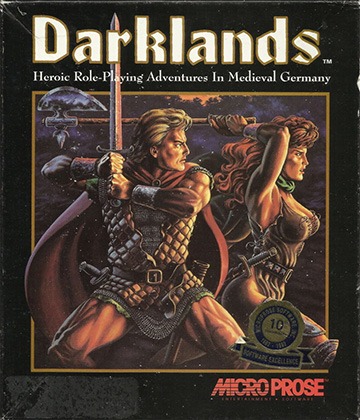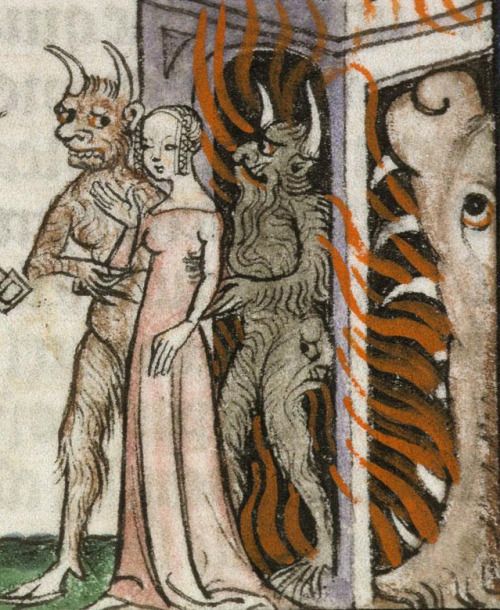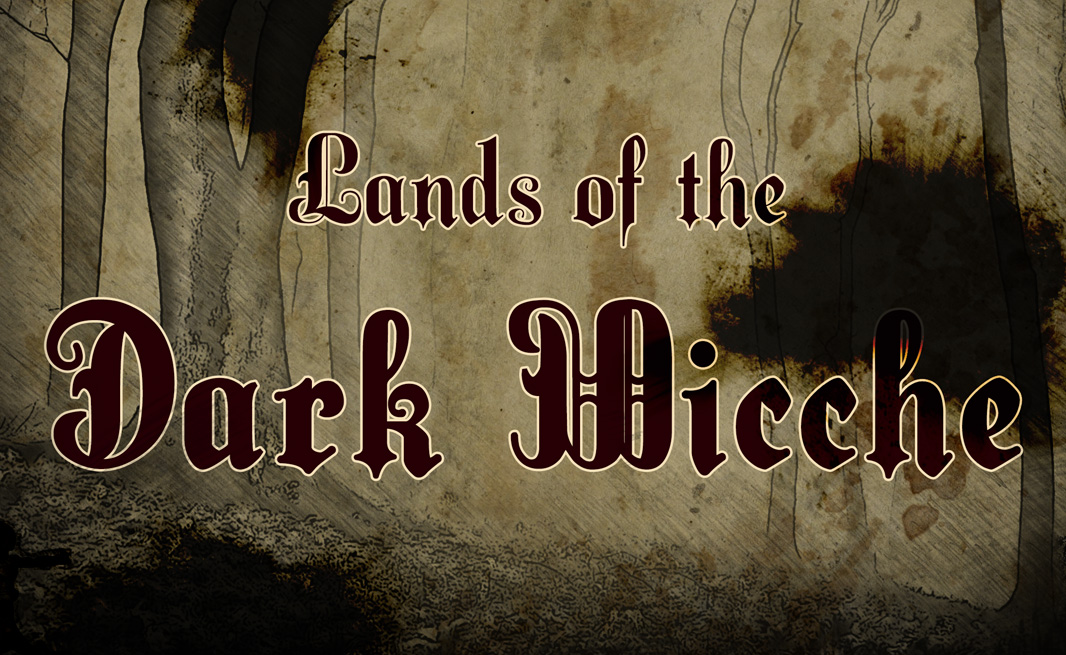One of my favorite old-school videogame RPGs was 1992’s Darklands. Set in medieval Germany, the game was brutally difficult, seeped in superstition and folklore, and — way ahead of its time — a massive sandbox you could explore. It was also incredibly buggy, had UX issues, and required some some serious autoexec voodoo to get to work (any gamer over the age of 40 knows what I’m talking about).

The result was I spent a lot more time thinking about playing Darklands than actually playing it. But the game stuck in my memory, and when I saw a new version of Call of Cthulhu Dark Ages had come out to rave reviews, I decided to try to reinvent the feel of superstitious, middle ages Germany from my memory.
Set in the early 1500s, the adventure Lands of the Dark Wicche trades traditional Lovecraftian horrors for the terrors of folklore — witches, fiery men, block mountains, and devil worshippers who lurk in the forest.
Separating Medieval from Fantasy
On the surface, a horror game set in the medieval era can feel a lot like a traditional fantasy game. You have swords, villages, bandits on the road, and some monstrous beast waiting to devour the heroes. But a medieval or dark ages game deserves its own feel separate from typical fantasy games.
Here’s a few tips to make your medieval games feel different from fantasy:
- Constrain the scope. People didn’t go far from their homes in the medieval ages. The next kingdom over was a long way away. In Lands of the Dark Wicche, I purposely set the entire adventure within a six hour walk of the starting point, and mostly along a single road.
- Religion was the center of life. In most fantasy games, organized religion is only lightly touched on. The medieval ages were immersed in religion. Uniquely, in medieval Germany, bishops themselves ruled entire kingdoms, which set up an interesting dynamic with the other nobles. I decided to center the entire plot of Lands of the Dark Wicche about a journey to meet with a bishop. Several important main NPCs are priests or friars. Two of the six pregenerated characters are in the clergy. And then, to double-down on the folklore part of the feel I wanted, I scattered saintly relics through the adventure. While these relics are barely potent, they serve to always remind the players that they are in the medieval era, not Faerun.
- Tie into real events. While this is good advice in any historical game, I did some research by reading The Flight and Fall of the Eagle: A History of Medieval Germany 800–1648. Medieval history is crazy complicated (and bloody), but tying your adventure into a real location and using some real people as NPCs added the authenticity I was looking for.
- The supernatural shouldn’t follow rules. My second source of research was Original Bavarian Folktales: A Schönwerth Selection. A contemporary of Grimm, Schönwerth’s stories are familiar… but different. What struck me about these old tales is how inconsistent they were with each other. Sometimes, a forest ogre would eat you, but other times he would show you your way home. Sometimes witches got punished for their evil deeds, other times they would fly away cackling that they avoided all retribution. My takeaway was that the unpredictable nature of the supernatural was one of the things that made them horrifying to folks who were used to a lot of rules in their every day lives. In Lands of the Dark Wicche, I made sure to include a few moments where the PCs can’t be sure how to react when they come upon one of these bizarre, folk creatures. And that talking to them, is way better than fighting them.
- No dungeons! Okay, this one is my own personal rule because I think 90% of my adventures feature a cave or dungeon. Although I truly love caves, I swore I wouldn’t use them. This definitely helps separate a medieval adventure from a Dungeons & Dragons excursion!

Following these north stars helped Lands of the Dark Wicche separate itself from a typical fantasy adventure. I also think that the avoidance of Lovecraftian monsters surprised my players. Being a Call of Cthulhu Dark Ages game, they were waiting for the cultists and summoned tentacled beasts to show up… but instead found bizarre situations they didn’t quite know how to handle. I think 5E players will enjoy the same uncomfortable feeling, especially using characters without overt magical abilities. Discomfort is perfect for the 1400s.
Download the free adventure, Lands of the Dark Wicche, here:
Get LANDS OF THE DARK WICCHE (GURPS Middle Ages)
Get LANDS OF THE DARK WICCHE (GURPS) - Printer Friendly
Get LANDS OF THE DARK WICCHE (Call of Cthulhu)
Get LANDS OF THE DARK WICCHE (Call of Cthulhu) - Printer Friendly
Get LANDS OF THE DARK WICCHE (Call of Cthulhu) - 黑女巫之地
Get LANDS OF THE DARK WICCHE (D&D 5E)
Get LANDS OF THE DARK WICCHE (D&D 5E) - Printer Friendly
Get LANDS OF THE DARK WICCHE - VTT Assets & Tokens
If you’d like to see a video overview of Lands of the Dark Wicche, check out my YouTube channel:
Do you have any tips for separating medieval from fantasy? Let everyone know in the comments below.
Related: Another videogame inspired adventure…


Portraits are noticeably better than usual. What kind of AI do you had used this time?
I did some heavy experimentation with Artbreeder – getting matching styles between the characters is harder than what I usually do, but I agree they are much nicer!
I am a Chinese CoC player and I love this adventure very much.
May I translate it into Chinese and post it publicly, sharing it with more Chinese players?
Additionally, I have some questions about the adventure.
1..p5,“ but the fortress was destroyed during its construction during the revolt of 1500.”
I think it is “1400”,not “1500”.
2.p10, the title of sidebar “Daemon goat”.
I don’t know German at all, so I want to know that is “Daemon” the German word of “Demon”?
3.p10,the daemon goat‘s fighting skills,“Dodge 60% (22/9)”.
Perhaps the right version is “Dodge 60% (30/12)”.
4.p11, sidebar”Black Tobe” shows “Armor: Leather and rings and helm (1D6+1)”.
Is the “rings” means the ornament on finger? I don’t think that”rings” could supply Armor point,so I guess the exact meaning is “Leather with rings and helm”. I know one kind of leather armor inlaid some iron rings. Do I misunderstand it?
Yes, happy to have you translate it! Let me know when you have finished it and I’ll link to it. Some answers to your questions:
1) Yes, this is a mistake, it should be 1400.
2) Yes, “daemon” is an older/alternate spelling of demon. They are basically the same thing.
3) Good catch! It should be 60% (30/12) like you say.
4) “Leather and rings” armor is taken from the Call of Cthulhu Dark Ages rulebook (p.106). I’m actually not entirely clear what it is supposed to represent, but I imagine the authors thought it was leather reinforced with chain mail. Historically, it’s more likely Black Tobe would be wearing hardened or boiled stiff leather armor (also known as cuir bouilli).
Glad you enjoyed the adventure, thanks for posting! I’ll update the adventure with some of the fixes above later tonight.
What does “burlery” means?
I have finished translating of text part.
But I can not understand that word in handout A, never be found in any dictionary.
It’s actually barley (though a bit hard to read because of the font), the type of grain grown in that region of Germany.
Oh,I am sorry.
The ”Burlery“ is in page 10,in the bottom right-hand corner of MAP 1:Jakob’s Mansion.
Ah! Butlery! Basically a store room or pantry with food and supplies.
leather and ring armor is basically leather reinforced with large metal rings. It is not as good protection as chain mail but may be easier to make.
There are many varieties of it and I think there is some overlap with “studded leather” armor and other reinforced leather armors… may be different names for the same thing.
A Google image search for “leather and ringmail armor” will give you some good pictures of it.
Ringmail armor
https://www.mytholon.com/thumbnail/94/d9/9e/1663159591/berengar_ringpanzerjacke_ringpanzer_beintaschen_fr_1280x1280.jpg
That would be the Leather and Rings I imagine
Hey,Thalcos!
I have finished,so how could I give the chinese version to you?
Email it to me or post a dropbox link? You can reach me at thalcos@ hotmail.com
Excited to see it!
I have sent it to your email.
I was stationed at Giebelstadt AAF in the late ’80s. Nice to see someone else sees the gaming value!
Hello from Brazil,
I introduced this adventure weeks ago to a group of just two characters. A hunter with little trust in the powerful people of Würzurg and a priest questioning his own faith. The game took place online, and therefore required three sessions to complete. For some reason, the players questioned all the supernatural aspects of the plot, and did not have any encounters with The Fiery Man. This caused me to change the ending, (SPOILER ALERT) making Otilie a woman without arcane abilities, using seduction and his knowledge of herbs to poison and drug in his quest for revenge. The game went very well. Excellent scenery.
That’s awesome – I like that you modified it to be all about superstition, vs. actual occult magic. Glad you had fun!
I noticed a few problems on the GURPS character sheets…
Volrad Warnekouw:
* Reaction of -2 from Status, but his Status is only -1.
Ckristina of Rostock:
* She has the Reputation modifiers for Truth-Seeker and Stubbornness from Father Poncellet.
* She should probably be literate, so she can write that book (unless she’s hired a scribe to write it for her?).
As always, thanks for all these adventures!
I too was a huge fan of Darklands in the early 1990s. All of my saved games developed the “blue hair bug”, but I kept playing. I never reached the end of the game, never found a dragon, and never survived even mid-level threats like knockers in the mines or the witches’ sabbath, but I did reduce robber-knights in central Europe to an endangered species.
I just noticed something in the CoC Dark Ages pdf. I seriously doubt that the Dominican monk Poncellet is a female as the character sheet states. 😉
Oh dear, how embarrassing for him! (Fixed in the new version)